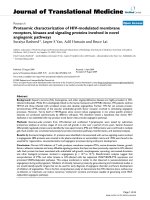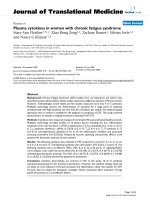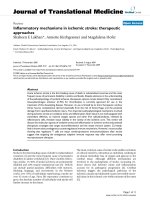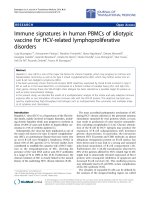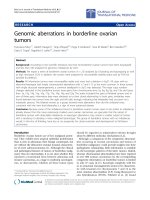Báo cáo hóa học: " Defect Characterization in SiGe/SOI Epitaxial Semiconductors by Positron Annihilation" ppt
Bạn đang xem bản rút gọn của tài liệu. Xem và tải ngay bản đầy đủ của tài liệu tại đây (382.75 KB, 6 trang )
SPECIAL ISSUE ARTICLE
Defect Characterization in SiGe/SOI Epitaxial Semiconductors
by Positron Annihilation
R. Ferragut
•
A. Calloni
•
A. Dupasquier
•
G. Isella
Received: 2 July 2010 / Accepted: 22 September 2010 / Published online: 24 October 2010
Ó The Author(s) 2010. This article is published with open access at Springerlink.com
Abstract The potential of positron annihilation spec-
troscopy (PAS) for defect characterization at the atomic
scale in semiconductors has been demonstrated in thin
multilayer structures of SiGe (50 nm) grown on UTB
(ultra-thin body) SOI (silicon-on-insulator). A slow posi-
tron beam was used to probe the defect profile. The SiO
2
/Si
interface in the UTB-SOI was well characterized, and a
good estimation of its depth has been obtained. The
chemical analysis indicates that the interface does not
contain defects, but only strongly localized charged cen-
ters. In order to promote the relaxation, the samples have
been submitted to a post-growth annealing treatment in
vacuum. After this treatment, it was possible to observe the
modifications of the defect structure of the relaxed film.
Chemical analysis of the SiGe layers suggests a prevalent
trapping site surrounded by germanium atoms, presumably
Si vacancies associated with misfit dislocations and
threading dislocations in the SiGe films.
Keywords Positron annihilation spectroscopy Á Ultra-
thin body films Á SiGe semiconductors Á Point defects
Introduction
Silicon–germanium (SiGe) has gained much attention in
recent years thanks to its promising electrical and material
properties. The complete solubility of the two elements
enables band gap engineering, and SiGe is relatively easy
to integrate into silicon technology. There are, however,
still numerous issues regarding the electrical and material
properties of SiGe that have to be clarified, e.g. the for-
mation of electrically active defect complexes such as
vacancy-type defects.
The positron annihilation technique is an established
method for investigating point defects in materials [1].
When a positron is implanted into condensed matter, it
annihilates with an electron and emits two 511 keV c-rays.
The energy spectrum of the annihilation c-rays is broad-
ened due to the Doppler effect associated with the
momentum component of the annihilating electron–posi-
tron pair. Positrons tend to be localized in vacancy-type
defects because of the Coulomb repulsion from ion cores.
Since the momentum distribution of electrons in such
defects differs from that in bulk materials, one can detect
the defects by measuring the Doppler-broadening spectra
of annihilation radiation. A frequently adopted parameter
used for characterizing the change in the Doppler-broad-
ening spectra is the so-called S parameter, which mainly
reflects changes in the low-momentum region of the elec-
tron momentum distribution [1].
Previous investigations comprise the study of semicon-
ductor layers (usually in the range of hundreds of nano-
meters) and semiconductor/oxide systems. The present
contribution deals with positron implantation into UTB-
SOI (ultra-thin body-silicon-on-insulator) and SiGe/SOI
multilayer structures (partially presented in Ref. 2). The
position and chemical environment of the SiO
2
/Si interface
in the UTB-SOI was well characterized. SiGe/SOI have
been proposed as an efficient way of producing strain-free
substrates by strain equalization between the top crystalline
layers or by strain transfer to the buried oxide [3, 4].
Chemical analysis of the annihilation site in the SiGe films
suggests a prevalent decoration of the trapping sites
(vacancy-like defects) with Ge atoms associated with misfit
R. Ferragut (&) Á A. Calloni Á A. Dupasquier Á G. Isella
L-NESS, Dipartimento di Fisica, Politecnico di Milano,
via Anzani 42, 22100 Como, Italy
e-mail:
123
Nanoscale Res Lett (2010) 5:1942–1947
DOI 10.1007/s11671-010-9818-4
dislocations and threading dislocations. The capabilities of
PAS include the identification and analysis of different
type of defects in epitaxial SiGe thin films and the UTB-
SOI substrate in a nondestructive manner.
Experimental Method
The UTB-SOI wafers, purchased from SOITEC
TM
, were
prepared according to the SmartCut
TM
process, based on
implantation and wafer bonding [5]. All the SOI wafers
used have a (100) crystal orientation and are slightly
p-doped (Boron 0.6-1.6 9 10
15
cm
-3
), as was the Si
reference sample.
The SiGe layers were grown on SOI by means of
LEPECVD (low-energy plasma-enhanced chemical vapor
deposition) [6]. The SOI samples were heated to a tem-
perature of 500°C for 136 s during SiGe growth. The SiGe
layers were grown with a 36% germanium atomic con-
centration (measured by X-ray diffraction). In order to
promote relaxation, the samples have been submitted to a
post-growth annealing treatment in vacuum (*10
-5
mbar).
SiGe layer and silicon substrate thickness were optimized
in order to give a substantial relative change (from 18 to
56%) of the degree of relaxation (normalized difference
between the measured lattice parameter and the strain-free
lattice parameter dependent on the germanium concentra-
tion) upon the annealing treatment. Investigated samples
are listed in Table 1.
The measurement was performed by means of a slow
positron beam, capable of implanting positrons with a
kinetic energy variable from 0.05 to 18 keV. The mean
positron implantation depth Z
m
depends on E according to
the formula
Z
m
¼
40
q
E
1:6
; ð1Þ
with Z
m
in nanometers when density q and positron
implantation energy E are expressed in grams per cubic
centimeter and keV, respectively [7].
The gamma rays produced by positron annihilation were
detected by means of a high purity germanium detector
with resolution (FWHM) of about 1.32 keV at 511 keV.
For each implantation energy, approximately 10
5
counts
were accumulated in the annihilation peak. Measurements
were taken in high vacuum conditions, *10
-9
mbar. The
annihilation energy spectra have been analyzed both by
extracting the full annihilation peak shape and by inte-
grating the annihilation peak in the energy interval
|E–511 keV| B 0.85 keV (S parameter). The area under the
peak (|E-511 keV| B 4.25 keV) was used for normaliza-
tion. Since the energy of the annihilation radiation is
Doppler shifted in the laboratory frame as a consequence of
a finite momentum of the positron–electron annihilating
pair along the line that connects the sample to the gamma
ray detector, the annihilation peak changes its shape
according to the momentum distribution of the electron
cloud seen by the positron. An increase of the S parameter
thus reflects an increased annihilation rate with free (i.e.
valence) electrons, while a broadening of the peak can be
linked to an enhanced interaction rate with more bound (i.e.
core) electrons.
Results and Discussion
Figure 1 shows the results of positron implantation into a
bare SOI substrate with an extremely thin (*2 nm) Si
layer on top. The S parameter evolution with the implan-
tation energy is shown in panel a, while panel b shows the
fraction of positrons annihilated into the oxide, the sub-
strate, and into the buried interface as computed by the
application of a positron implantation and diffusion algo-
rithm by means of the VEPFIT program [8]. Although
positrons are not directly implanted at interfaces, a sub-
stantial fraction of positrons should annihilate into the
buried interface at implantation energies higher than
2 keV. The evident dip in the S parameter curve at about
3.5 keV is certainly related to strong positron trapping at
interface. This is confirmed by the excellent fit of the
experimental data with the VEPFIT model (solid line in
Fig. 1a). This line is the outcome of several attempts with
different models (sets of VEPFIT input data), which in all
cases imply the presence of a positron trapping region
corresponding to the nominal position of the Si/SiO
2
interface. The VEPFIT curve in Fig. 1a was obtained by
assuming an oxide surface and four more layers: Si, SiO
2
,
SiO
2
/Si interface, and a semi-infinite Si layer. The corre-
sponding best-fit values of positron diffusion lengths L
?
,
thicknesses, and S-parameters of the different layers are
reported in Table 2. It was necessary to fix some parame-
ters (labeled F in Table 2). In accordance with Refs. [9]
and [10], the interface was modeled as a very thin layer
(1 nm) with a short positron diffusion length (L
?
*1 nm).
The best-fit value of the depth of the interface coincides
within the experimental error with the nominal value. The
introduction of an electric field near the interface region is
Table 1 Characteristics of the samples used in current measurements
Sample Structure
a
Thermal treatment
SOI 2 Si/147 SiO
2
/Si As-received
SiGe (a) 50 Si
0.64
Ge
0.36
/10 Si/147 SiO
2
/Si As-grown
SiGe (b) 50 Si
0.64
Ge
0.36
/10 Si/147 SiO
2
/Si 33 min at 750°C
a
Thicknesses are given in nanometers. All samples were covered by
a thin layer of natural oxide (*2 nm)
Nanoscale Res Lett (2010) 5:1942–1947 1943
123
also possible (*300 V/cm), but in this case, it is necessary
to fix the interface position at the nominal value (147 nm).
Attempts to introduce another absorbing layer at the first
Si/SiO
2
interface seem arbitrary.
Figure 2 shows the ratio of the positron–electron anni-
hilation peaks of the surface, the SiO
2
layer, and the
SiO
2
/Si interface relative to the bulk silicon peak. The
surface and interface signals were obtained by means of a
linear combination between the oxide, the interface, and a
silicon bulk contributions, with the weights given by the
fractions shown in Fig. 1b. Since both the positron
Table 2 Results obtained in the Si/SiO
2
/Si SOI heterostructure from
the positron lineshape profile (Fig. 1) using VEPFIT
L
?
(nm) t (nm) S parameter
Surface \1 *2F 0.508 ± 0.003
Si 220F 2F 0.551F
SiO
2
17 ± 4 149 ± 3 0.541 ± 0.002
SiO
2
/Si interface *1F *1F 0.525 ± 0.004
Si 220 ± 20 ? 0.551 ± 0.001
Positron diffusion length L
?
, thickness t, and Doppler S parameter.
Fixed parameters are marked with the letter F
0.50
0.51
0.52
0.53
0.54
0.55
0.56
0
1500
1000
10 500
200
100
(b)
VEPFIT model
S parameter
(a)
50
024681012141618
0.0
0.2
0.4
0.6
0.8
1.0
Mean implantation depth (nm)
Implanted into SiO
2
Implanted into Si substrate
Diffused and annihilated into SiO
2
Diffused and annihilated at the interface
Diffused and annihilated into Si substrate
Silicon substrate
SiO
2
Implanted and
annihilating fractions
Positron implantation energy (keV)
SiO
2
/Si interface
Fig. 1 a S parameter as a function of the positron implantation
energy in the SOI sample. Error bar is shown for one point only.
b Dashed lines represent the fractions of positrons implanted into the
oxide (blue) and the silicon substrate (red), calculated according to
Ref. [11]. The continue and dash-doted lines represent the fractions of
positrons that annihilate after diffusion in the oxide (blue), at the
buried interface (green) and into the substrate (red). Surface effects
are not visible in the picture (important only at low energies). The
upper scale gives the mean positron implantation depth calculated
according to Eq. 1
0 5 1 0 15 20 25 30
0.8
1.0
1.2
1.4
1.6
1.8
2.0
Silicon surface
Silicon oxide
SiO
2
/Si interface
Ratio to bulk Si
Momentum (10
-3
m
0
c)
Fig. 2 Ratios of the positron–electron momentum distribution at the
surface of a silicon reference sample, in the silicon oxide and at the
buried interface (relative to bulk Si)
1944 Nanoscale Res Lett (2010) 5:1942–1947
123
diffusion coefficient and the lineshape parameters relative
to the thermally grown oxide and to the silicon substrate are
known from the literature and from calibration experiments
on bulk samples [12], the interface Doppler peak shape can
be extracted. The interface peak of the Doppler ratio curve
of Fig. 2 is characterized by a flat region at low momentum
and by a peak at *12 mrad (12 9 10
-3
m
0
c) due to
annihilation with tightly bound oxide electrons. The
absence of a clear signal of an increment of annihilation
with nearly free electrons (visible at momentum zero in
Fig. 2) and the need of a trapping layer at the interface
convey the idea that positrons do not annihilate into voids,
but rather that they are strongly localized at charged centers,
most probably representing electron states created by the
presence of silicon dangling bonds [13, 14], as already
demonstrated in positron implantation experiments with
SiO
2
/Si samples [7] and that they sense a relatively well-
ordered oxide structure, typical of low quartz [15]. The
same annihilation environment can be found more or less at
any semiconductor surface covered with thermally grown or
natural oxide, as seen in Fig. 2.
Figure 3 shows the experimental S parameter profiles of
the SiGe/SOI samples listed in Table 1. The approximated
mean implantation depth was calculated according to Eq. 1
(the density of the SiGe layer has been estimated to be
3.52 g/cm
3
). The results indicate the existence of a wide
plateau up to *50 nm in both samples, which corresponds
to the SiGe layer, and changes in height appear after the
thermal treatment. Given the mixing between the signals
coming from the oxide and from the SiGe/Si layers,
changes in the surface layers morphology can be appreci-
ated by comparing the two S parameter evolutions relative
to the sample before and after structural relaxation due to
the annealing step. The increase of the S parameter at low
implantation energy can be thus directly related to an
enhanced interaction with free electrons. The exact posi-
tioning of the defected region is behind the resolution
limits of the current measurements, given that the positron
diffusion length in intrinsic semiconductors can be as high
as 240 nm [12].
In order to gain more understanding on the environment
of the positron annihilation site, we have averaged the
Doppler peak shape relative to a mean implantation depth
between 2 and 30 nm (the plateaus in Fig. 3). Lower
implantation energies have been neglected since they bring
information also from the annihilation of positron from
non-thermalised ensemble and from the natural oxide layer.
According to both precise VEPFIT simulations and to
simplified models of positron implantation, positrons
implanted at energies lower than 2 keV annihilate almost
exclusively in the topmost SiGe/Si layers. Since the dif-
fusion length of positrons into bulk semiconductors
exceeds the actual thickness of these layers, the annihila-
tion peak shape prevalently resembles the one character-
istic of annihilation at the oxide/semiconductor interface.
The differences between the peak shape relative to the as-
grown sample and to the annealed one are shown in Fig. 4
and are related to an increased annihilation with low- and
high-momentum electrons. The former effect is reflected in
the increase of the S parameter, as seen in Fig. 3 and can be
associated with an increase of positron annihilation at
defects, and the latter can be interpreted as a modification
of the chemical environment of the positron annihilation
site.
The chemical sensitivity of positrons has been demon-
strated in metals and semiconductor systems [16, 17].
0.1 1 10 100 1000
0.51
0.52
0.53
0.54
0.55
SiSiO
2
Si
SiGe (a)
SiGe (b)
S parameter
Mean implantation depth (nm)
SiGe
Fig. 3 S parameter as a function of the mean implantation depth:
SiGe a ‘‘as grown’’ (full symbols); SiGe b annealed (open symbols).
Continuous and dashes lines are VEPFIT simulations, while vertical
dashed lines mark the position of interfaces (after Ref. [2])
0 5 10 15 20
0.8
1.0
1.2
1.4
1.6
1.8
2.0
2.2
Ratio to bulk Si
Momentum (10
-3
m
0
c)
defected germanium
surface/interfaces
SiGe (a) fit (a)
SiGe (b) fit (b)
Fig. 4 Ratios of the positron–electron momentum distribution of the
annihilating pair in SiGe a ‘‘as grown’’ (full symbols) and SiGe
b annealed (open symbols) relative to bulk Si. Linear combination fits
for a ‘‘as grow’’ (short dashed line) and b annealed (dot-dashed line).
The reference spectra of defected Ge and surface/interface are shown
with continue and dashed lines (after Ref. [2])
Nanoscale Res Lett (2010) 5:1942–1947 1945
123
Following the procedure outlined in [18], we have
reproduced the measured annihilation peak shapes with a
linear combination of Doppler spectra of the semicon-
ductor/oxide interface and the Ge signal of a sample
saturated of defects. The obtained fits are shown in Fig. 4.
As discussed in Ref. [2], the results of this latter analysis
to the data of Fig. 4 show an increment in the germanium
component from (22 ± 10)% to (47 ± 8)% after the
annealing. The indetermination of this component is
associated with the spread of the experimental data,
especially at high momentum. In particular, in order to
better reproduce the measured Doppler spectra on the
whole momentum scale, we have employed, instead of the
annihilation peak shape characteristics of annihilation into
bulk germanium, the shape measured from a thick (in the
microns range) layer of germanium grown on silicon. The
abrupt junction between germanium and silicon promotes
the formation of misfit dislocations at the interface and
threading dislocation that run across the whole germa-
nium layer with an estimated density of about 10
9
cm
-2
.
Positrons are trapped at defect sites causing a substantial
reduction of the diffusion length and a slight increase of
the S parameter. This experimental finding can be
explained by postulating positron annihilation at vacan-
cies associated with dislocations, or at negatively charged
centers associated with dislocations, given that the
deposited Ge layer was free of contaminants or dopant
atoms, which are known to produce positron trapping
defects [1]. The decomposition of the annihilation spectra
into two terms (interface and ‘‘germanium defects’’) gives
an acceptable fit (v
2
/[degrees of freedom] values of 1.5 in
the as-grown sample and 1.2 in the annealed sample) and
conveys the idea of a prevalent decoration of positron
trapping centers with germanium atoms (as already
pointed out by Rummukainen et al. [19] in bulk SiGe
layers), mainly associated with Si vacancies.
Conclusions
This work presents the characterization of SOI and SiGe/
SOI samples.
(i) The SiO
2
/Si interface in the UTB-SOI was identified
with accuracy. It was possible to estimate the depth
where the interface is located with good precision. The
chemical analysis at the surface and the interface
shows that positrons do not annihilate into large
defects (voids), but rather that they are strongly
localized close to the silicon surface. The observed
momentum distribution is characteristic of annihila-
tion in a relatively well-ordered oxide structure,
typical of low quartz [15], and the strong localization
can be explained with annihilation at negatively
charged centers, like silicon dangling bonds [7, 14].
(ii) The process of strain relaxation in thin SiGe layers
grown on SOI substrates has been analyzed. Relax-
ation of the strained structure has been found to
proceed via the introduction of new defects, presum-
ably Si vacancies, able to trap positrons. Chemical
analysis of the annihilation site suggests a prevalent
decoration of the trapping sites with germanium
atoms. The formation of lattice defects in the form of
misfit dislocations between two adjacent layers and
threading dislocations in the SiGe substrate are
certainly associated with the identified defects.
It is demonstrated that the analysis of positron data
coming from extremely thin surface layers is possible
thanks to the reduced implantation range of positrons at
low implantation energy and to the enhanced contrast due
to the prevalent annihilation of not trapped positrons with
strongly bound surface/interface oxide electrons.
Acknowledgments This work has been partially supported by the
CARIPLO project MANDIS.
Open Access This article is distributed under the terms of the
Creative Commons Attribution Noncommercial License which per-
mits any noncommercial use, distribution, and reproduction in any
medium, provided the original author(s) and source are credited.
References
1. R. Krause-Rehberg, H. Leipner, Positron Annihilation in Semi-
conductors (Springer, Berlin, 1999)
2. A. Calloni, R. Ferragut, F. Moia, A. Dupasquier, G. Isella,
D. Marongiu, G. Norga, A. Federov, D. Chrastina, Phys. Stat. Sol.
(C) 6, 2304 (2009)
3. A.R. Powell, Appl. Phys. Lett. 64, 1586 (1994)
4. F.K. LeGoues, A. Powell, S.S. Iyer, J. Appl. Phys. 75, 7240
(1994)
5. M. Bruel, Nucl. Instr. Meth. B 108, 313 (1996)
6. C. Rosenblad, H.R. Deller, M. Do
¨
beli, E. Mu
¨
ller, H. von Ka
¨
nel,
Thin Solid Films 318, 11 (1998)
7. P. Asoka-Kumar, K.G. Lynn, D.O. Welch, J. Appl. Phys. 76,
4935 (1994)
8. A. van Veen, H. Schut, J. de Vries, R.A. Hakvoort, M.R. Ijpma,
AIP Conf. Proc. 218, 171 (1990)
9. A. Uedono, L. Wei, S. Tanigawa, R. Suzuki, H. Ohgaki,
T. Mikado, K. Fujino, J. Appl. Phys. 75, 216 (1994)
10. R.S. Brusa, G.P. Karwasz, G. Mariotto, A. Zecca, R. Ferragut,
P. Folegati, A. Dupasquier, G. Ottaviani, R. Tonini, J. Appl. Phys.
94, 7483 (2003)
11. A. Vehanen, K. Saarinen, P. Hautoja
¨
rvi, H. Huomo, Phys. Rev. B
35, 4606 (1987)
12. P.J. Schultz, K.G. Lynn, Rev. Mod. Phys. 60, 701 (1988)
13. M.H. White, J.R. Cricchi, IEEE Trans. Electron Dev. 19, 1280
(1972)
14. S.M. Sze, K. Kwok, Ng, Physics of Semiconductor Devices, 3rd
edn. (Wiley, New Jersey, 2007)
1946 Nanoscale Res Lett (2010) 5:1942–1947
123
15. G. Brauer, W. Anwand, W. Skorupa, A.G. Revesz, J. Kuriplach,
Phys. Rev. B 66, 195331 (2002)
16. S. Szpala, P. Asoka-Kumar, B. Nielsen, J.P. Peng, S. Hayakawa,
K.G. Lynn, H J. Gossmann, Phys. Rev. B 54, 4722 (1996)
17. A. Dupasquier, R. Ferragut, M.M. Iglesias, M. Massazza,
G. Riontino, P. Mengucci, G. Barucca, C.E. Macchi, A. Somoza,
Phil. Mag. 87, 3297 (2007)
18. P. Folegati, I. Makkonen, R. Ferragut, M.J. Puska, Phys. Rev. B
75, 054201 (2007)
19. M. Rummukainen, J. Slotte, K. Saarinen, H.H. Radamson, J.
Hallstedt, A.Yu. Kuznetsov, Phys. Rev. B 73, 165209 (2006)
Nanoscale Res Lett (2010) 5:1942–1947 1947
123



